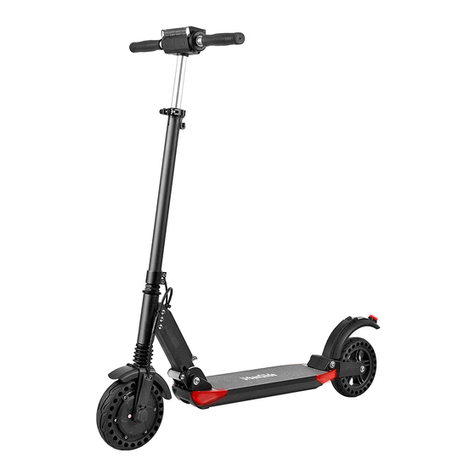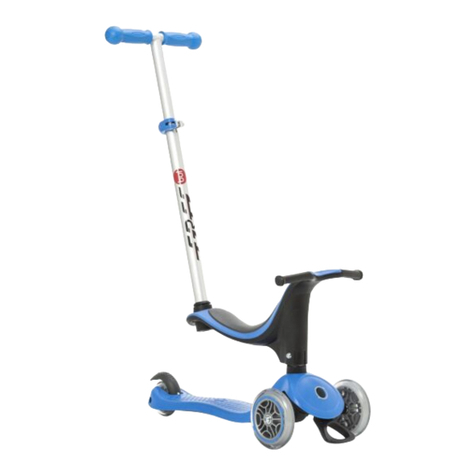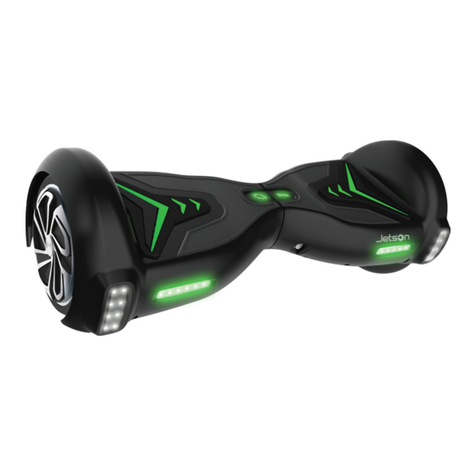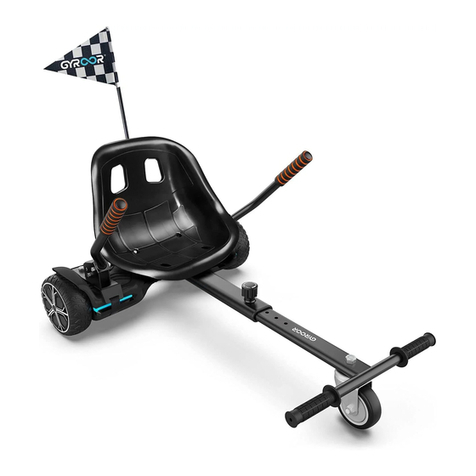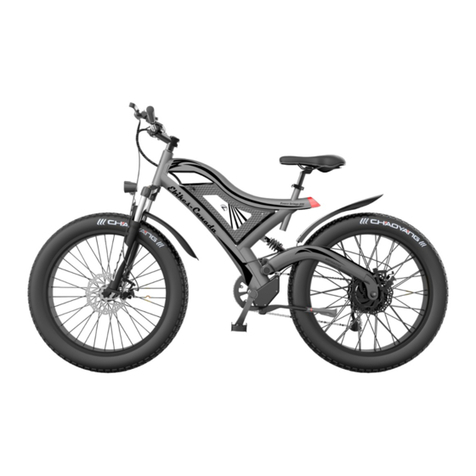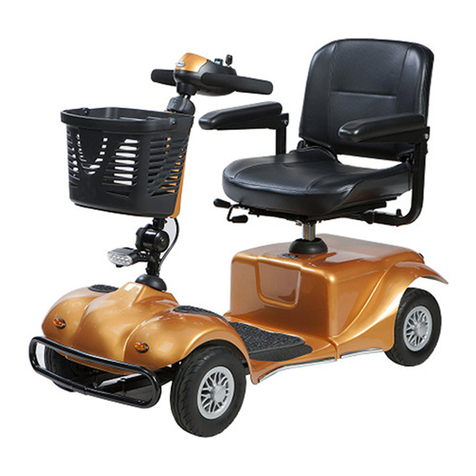BEZIOR M1 User manual

User Guide
INSTRUCTIONS
Smart EV/Moped
Model: M1
Operation Manual
EN DE FR IT ES

CONTENTS
English················ 1-12
Français············· 13-26
Italiano·················27-44

EN-1
Precautions
Battery and charging:
Charging is only allowed at 0°C~45°C, and discharging is only allowed at
-20°C~60°C. The battery must be kept dry. It is strictly prohibited to put
the battery in acidic or alkaline liquid. Rain must be avoided, and it shall
be kept away from fire, heat and high temperature environment. It is
strictly prohibited to reverse the battery's positive and negative poles or
damage them, plug in the battery or let it suffer from short circuit. Please
use the original special charger when charging. The charging must not
last more than 6 hours, and the charging current does not exceed 2A.
When not in use for a long time, please keep the battery in a cool and dry
place, and charge it for five hours every month. Users must follow the
instructions when charging, otherwise they will be at their own risk.
Attention shall be paid to the type of battery to which the charger is
compatible and the applicable voltage, and mixing is strictly prohibited.
When charging, it shall be placed in a ventilated environment. It is strictly
prohibited to charge in a residential building and in an enclosed space or
in a hot environment. When charging, insert the battery first, and then
supply the mains power; when fully charged, cut off the mains power first,
and then unplug the battery connector. When the green light is on, the
power shall be cut off in time. It is forbidden to connect the charger to
the AC power supply without load for a long time without charging.
During the charging process, if the indicator light is abnormal, a peculiar
smell occurs, or the charger case is overheating, stop charging
immediately and repair or replace the charger. During the use and
storage of the charger, be careful not to let foreign matter enter,
especially avoid inflow of water or other liquids, so as to avoid short
circuit inside the charger.
The charger should not be carried with the vehicle. If it is necessary to
carry it, it shall be placed in the tool box after shock absorption
treatment. Do not disassemble or replace the accessories in the charger
by yourself.
Riding:
Do not use until you have read the instructions carefully to understand
the performance of the product; do not lend it to anyone who does not
manipulate the product. Before riding, check if the brakes are working.
When braking, please apply the rear brake first, and then apply the front
brake. Pay attention to the tightness of the brakes. When you find that
the brakes are too loose, you can use a internal hexagonal wrench to
tighten it. Note that the braking distance shall be increased when you are
riding in rain or snow. Applicable age: 16 to 65 years old.
Be sure to wear a safety helmet while riding it, follow the traffic rules, and
do not drive on motorized lanes and roads with many pedestrians.
Please check the tire pressure before riding. The recommended tire

EN-2
pressure is 35~45PSI.
The speed at downhill and non-brick pavement does not exceed
15km/h. Be careful not to bump the motor vigorously when it is
used, and keep the

EN-3
spindle lubricated.
Do not ride at more than the maximum load of the car body
(maximum load: 120kg)
After use, the car cannot be parked in the building's entrance hall,
evacuation stairs, or emergency exit. It must be properly parked in
accordance with safety regulations.
No one-handed riding!
Disclaimer:
After riding, please place the vehicle in a place free from sunlight and rain,
not in a residential building;
Check the motor and brake frequently;
Check the screws of the vehicle and the places to be tightened regularly,
and tighten them regularly.
Recommended torque: (unit: kgf.cm) handlebar screws 60-80, stem
screws 175-200, seat screws 175-200, and wheel screws 320-450;
The front and rear wheels of the vehicle shall be located in the center of
the fork or frame;
Check the spell frequently for any scars, cracks, or excessive wear. The
inner tube and the air nozzle shall be perpendicular to the hub. The
cover tyre that is damaged or excessively worn needs to be replaced
immediately, please ask a professional technician to replace your tyre. If
your cover tyre accidentally punctures and leaks, please contact a
professional technician to repair or replace it.
Maintenance and care:
For the product model, specifications or related information mentioned in this
Operation Manual, the company reserves the right of modification and final
interpretation; the functions of the specific model mentioned in this Operation
Manual are only applicable to that specific model;
The product models, specifications, or related information mentioned in
the Operation Manual may be changed without notice; without prior
written permission of the company, the Operation Manual may not be
copied, modified, reproduced, transmitted, or published in any form.
Please read the Manual carefully before using the product, and operate in
accordance with the Manual, otherwise the company will not be liable for
product damage or personal or property damage caused by improper
use or error.

EN-4
Figure 2
(Left Side of
Frame)
Figure 1 (Whole Vehicle Diagram)
①Variable speed shifter
②Brake lever
③Dash board
④Stem
⑤Headlight
⑥Spoke lamp
⑦Tyre
⑧Hub
⑨Damping front fork
⑩Front axle locking quick release
⑪Disc brake block
⑫Disc brake
⑬Lithium battery
⑭Sprocket
⑮Pedal
⑯Chain
⑰Flywheel
⑱Rear derailleur
⑲Drive motor
⑳Seat tube adjustment quick release
㉑Rear light
㉒Seat tube
㉓Saddle
㉔Battery charging hole
㉕Battery lock keyhole
USB output port

EN-5
Function introduction:
1.Charging: Referring to Figure 2, on the left side of the frame, you can see the charging hole
of battery; connect the charger to start charging; when the battery capacity is displayed to
be full, and the charger indicator light changes from red to yellow-green, it means the
battery is fully charged.
2.
Turn on: Referring to Figure 3, press and hold the "i" key to turn on/off the power.
3.Battery indicator: The instrument panel lights up after power-on. The battery is displayed in
four grids, corresponding to high, medium and low battery.
4.Headlight: Referring to Figure 3, press and hold the "+" key to turn on/off the headlight.
5.Start-up model: power riding. Step on the vehicle sprocket, and start the electric power
automatically after a certain speed is gained. If no power is needed, turn off the power or
the battery.
6.Speed change: Referring to Figure 4, turn the speed change shifter while the vehicle is
moving to achieve speed change from gear 1 to gear 7.
Left
variable
speed
shifter
"+" is an upshift key; press and
hold this key to turn on the
headlight
Press and hold the "i"
key to turn on/off the
power
"-" is an downshift
key; press and hold
this key to power the
driving
Figure 3 (left handlebar)
Mechanical bel Right variable speed shifter
Speed stage indication window
Figure 4 (right handlebar)

EN-6
Remove the battery
1.Insert the key into lockhole by left hand, press it to the bottom, rotate it to the left in position, and keep still; 2.In
the meantime, grasp the handle of battery by right hand to pull the battery out.
Battery capacity
button
Power indicator
light
Press this button on the battery box to display the battery
capacity after the indicator light is lightened. More indicator lights
lightened shows more battery capacity.
Battery charging hole
This is the state after the battery is pulled
out. The battery can be taken out and
charged separately
Note: The pedals are not installed at the
factory and can be installed by using the
special wrench coming with the vehicle.
Note when installing the pedals: The pedal with "R"
symbol is the right pedal, and that with the
"L" symbol is the left pedal.

EN-7
Product Parameters
Parameters
Standard Edition
Dimensions
Car body materials
Aluminum alloy
Body dimensions
1780*670*1120mm
Distance from pedal to ground
100mm
Tyre dimensions
27.5 inches
Package dimensions
139*19*75cm
Performanc
e
parameters
Car body weight
30kg
Maximum load
120kg
Best riding speed
20km / h
Maximum speed
25km / h
Endurance mileage
50~55km
Maximum climbing angle
30 degrees
Operating temperature
-10~45°C
Waterproofing grade
IP 54
Electrical
specifications
Type of battery
18650 lithium-ion power battery
Battery capacity
12.5AH
Battery rated voltage
48V
Motor line type
Power
Motor rated voltage
48V
Motor rated power
250W
Charging voltage
DC56V/2A
Input voltage
AC220V
Undervoltage protection value
31V
Overcurrent protection value
1.5A
Charging time
8~10 hours
Product Features
Instrument display
Multi-function LCD screen
Front lighting
Yes
Braking method
Front and rear disc brakes
Tyre style
Pneumatic tyre
Remarks: electric quantity, load, tyre pressure, pavement environment, chain and axle
lubrication degree, etc. will affect the maximum speed; the endurance mileage is
measured at a load of 60kg and a speed of 15~25km/h on flat and hardened road
under continuous testing from 100% power capacity to 0% power capacity; driving
habits, temperature, load, tyre pressure, pavement environment and other factors will
affect the endurance mileage.

EN-8
Arrow mark
Arrow mark
Product Description and Characteristics
•
Part description
1. 1.77'' inch, 160x128 color TFT LCD
screen
2. USB port with protective cover
3. Mounting bracket
•
Technical Parameters
4.
"+" button
5.
"i" display function button
6.
"-" button
Rated operating voltage
24V /3 6V /48 V DC
USB port output
5V,500mA
Operating temperature
-10°C ~+45°C
Storage temperature
-20°C -+60°C
Installation Instructions
•
Installation of BC-18 device
1.
Use M3 hex socket key, tighten screw 1, and fix the instrument to the left side of the
handlebar. Tightening torque: 0.2N.m. Do not over-tighten it, otherwise the surface of the
instrument may be damaged.
2.
Align the two arrow marks and firmly connect the cable on the instrument with the cable
on the electric bicycle controller.

EN-9
Status
Bar
Motor output
energy
Riding speed
Speed stage
Information
display area
Headlight
status
Time
Lithium battery
capacity
Data indicator
Instrument interface
•
Instrument interface is the default interface on the instrument
•
Key function
1. "+" key:
Short press once
Long press for 3
seconds
Press and hold for a long
time
Instrument
functions
Increased power
Headlight on/off
----
Menu interface
Cursor
up/increase
----
----
2. "-" key:
Short press once
Long press for 3
seconds
Press and hold for a long
time
Instrument functions
Decreased power
----
6 km/h mode
Menu interface
Cursor
down/decreas
e
Cancel and return
----

EN-10
Mileag
e
Total
mileage
Maximum driving
speed
Average
speed
Real-time motor output power Today's riding
time
Today's calories
burned
3. "i" key:
Short press once
Long press for 3
seconds
Press and hold for a long
time
Instrument functions
Change
information
display
Instrument system
On/Off
Menu interface
OK/Confirm
----
----
4. & Press both keys simultaneously:
Short press once
Long press for 3
seconds
Press and hold for a long
time
Instrument
functions
----
Enter the menu interface
----
Menu interface
----
Save changes and exit
----
Information Display Area
In the instrument interface, short press the "i" key for circulation browsing of the
information of various riding and electric bicycles.
* If the electric bicycle is not ridden, the riding time statistics will be
suspended and reset to zero at 00:00 every day.

EN-11
* Calories and riding time statistics are reset to zero at 00:00 every day.

EN-12
Changing the parameters in the "System Configuration" without knowledge may
cause the electric bicycle to have malfunction.
It may even make driving unsafe.
Before making any modifications yourself, consult the manufacturer.
System configuration precautions
System Operation
•
Initial operation
Set the system time
1. Press the "+" and "-" two keys simultaneously and hold for 2 seconds to enter the
main menu page of the system
2.
Press the "+" key and select the "Display Setting" field, and then press "i" to confirm
3. Use the same method to select "Set Date & Time" and other items below
4. On each page, you can adjust the parameters by pressing the "+" and "-".
5.
The parameter being adjusted is displayed as a flashing number.
6.
After the adjustment is completed, press "i" to confirm and continue to the next parameter
setting until all parameters are set.

EN-13
Other Interfaces
•
Error code notification
List of error codes (example only, depending on customer)
Error code
Corresponding error
conditions
Solutions to corresponding errors
21
Controller protection
Check if the three-phase power line is
connected properly
22
Accelerator error
Check accelerator conductor connections and
replace motor if necessary
23
Motor phase error
Check motor conductor connections and
replace motor if necessary
24
Speed sensor error
Check the speed sensor conductor
connections and replace the sensor if
necessary
25
Brake error
Check the brake system conductor
connections and replace the brake system if
necessary
30
Communication error
Check joints and contacts between parts

FR-14
Consignes à observer
Batterie et charge:
La charge de batterie est limitée à 0°
C
~
45°
C,
la décharge est à
-20°C~
60°C. Il faut garder la batterie au sec, il est interdit de placer la batterie dans
un liquide acide ou alcalin, il faut éviter la pluie, le feu, la chaleur et les
températures élevées. Il est strictement interdit d'inverser les côtés positifs et
négatifs de la batterie, et il est strictement interdit d’abîmer, d'insérer ou de
court-circuiter la batterie. Il faut utiliser le chargeur spécial d'origine lors de la
charge avec un temps de charge ne dépassant pas 6 heures, et le courant
de charge ne doit pas dépasser 2A. Lorsqu'elle n'est pas utilisée pendant
une longue période, il faut la conserver dans un endroit frais et sec et la
charger pendant cinq heures par mois. Les utilisateurs doivent suivre les
instructions lors de la charge, sinon ils en subiront les conséquences. Faire
attention au type de batterie que le chargeur peut charger et à la tension
applicable, et ne pas les mélanger. Lors de la charge, la batterie doit être
placée dans un environnement ventilé, il est strictement interdit de la charger
dans un immeuble résidentiel et dans un espace clos ou dans un
environnement chaud et bien ensoleillé. Lors de la charge, brancher
d'abord la batterie, puis l’alimenter, une fois complètement chargée, couper
d'abord l’alimentation, puis débrancher la batterie. Lorsque le voyant vert est
allumé, l'alimentation doit être coupée à temps. Il est interdit de connecter le
chargeur à l'alimentation pendant une longue période sans charge. Pendant
le processus de charge, si le voyant est anormal, une odeur inhabituelle
apparaît ou le boîtier du chargeur surchauffe, arrêter immédiatement la
charge et réparer ou remplacer le chargeur. Lors de l'utilisation et du
stockage du chargeur, veiller à empêcher les corps étrangers de pénétrer, en
particulier pour éviter tout afflux d'eau ou d'autres liquides, afin d'éviter les
courts-circuits à l'intérieur du chargeur. Le chargeur ne doit pas être
transporté avec le véhicule. S'il est nécessaire de le transporter, il doit être
placé dans la boîte à outils après le traitement d'absorption des chocs. Il ne
faut pas démonter ou remplacer les accessoires du chargeur sans la
présence d’un professionnel.
Faire du vélo:
Ne pas utiliser le vélo avant d'avoir lu attentivement les instructions pour
comprendre
les performances du produit; ne pas le prêter à personne qui ne manipule
pas le produit. Avant de faire du vélo, vérifier si les freins fonctionnent ou
non. Lors du freinage, veuiller d'abord actionner le frein arrière, puis le frein
avant. Il faut faire attention à l'élasticité du frein, si vous trouvez que le frein
est trop lâche, vous pouvez utiliser une clé six-pans pour le serrer. La
distance de freinage doit être augmentée lorsque vous roulez sous la pluie
ou sous la neige. Âge applicable: 16 à 65 ans.
Assurez-vous de porter un casque de sécurité lorsque vous roulez à vélo,
suivez les directives de circulation et ne roulez pas sur des voies
motorisées et des routes avec de nombreux piétons. Veuillez vérifier la
pression des pneus avant de rouler. La pression des pneus recommandée

FR-15
est de 35
~
45PSI.
La vitesse sur la chaussée en descente et non en brique ne dépasse pas 15
km/h. Lorsque vous utilisez le moteur, veillez à ne pas le cogner
vigoureusement et à garder l'arbre lubrifié.

FR-16
Ne roulez pas avec une charge qui dépasse la charge maximale du
corps (charge maximale est de120KG)
Après l’utilisation, il ne faut pas garer le vélo dans le hall d'entrée du bâtiment,
les escaliers d'évacuation ou la sortie de sécurité. Il doit être correctement garé
conformément aux règles de sécurité.
Il est interdit de faire du vélo à une main!
Exposé de responsabilité:
Après avoir roulé, veuillez placer le vélo dans un endroit à l'abri du soleil et de la
pluie, pas dans un immeuble résidentiel;
Vérifiez fréquemment le moteur et le frein;
Vérifiez régulièrement les vis du vélo et les endroits à serrer, et serrez-les
régulièrement.
Force de torsion recommandée: (unité: kgf.cm) les vis de support de potence
60-80, les vis de support de guidon175
~
200, les vis de selle 175
~
200,
les vis de roue 320
~
450;
Les roues avant et arrière doivent être situées au centre de la fourche avant
ou au centre du cadre;
Vérifiez fréquemment la rotation pour détecter des cicatrices, des fissures ou
une usure excessive. Le pneu intérieur et la buse d'air doivent être
perpendiculaires au moyeu de roue. Au cas d’une usure excessive ou d’un
endommagement, les pneus usés extérieurs doivent être immédiatement
remplacés, veuillez trouver un technicien professionnel pour remplacer vos
pneus. Si votre pneu est accidentellement crevé et qu’il fuit, veuillez
contacter un technicien professionnel pour le réparer ou le remplacer.
Entretien et maintenance:
Pour le modèle de produit, les spécifications ou les informations connexes
mentionnées dans ce mode d’emploi, la société se réserve le droit de
modification et d'interprétation finale; Les fonctions pour le modèle
spécifique mentionné dans ce mode d’emploi sont uniquement applicables à
ce modèle spécifique;
Le modèle de produit, les spécifications ou les informations connexes
mentionnées dans ce mode d’emploi peuvent être modifiés sans préavis;
sans l'autorisation écrite préalable de la société, ils ne peuvent être copiés,
modifiés, reproduits, transmis ou publiés sous quelque forme que ce soit.
Veuillez lire attentivement ce mode d’emploi avant d'utiliser le produit et
opérer conformément audit mode, sinon la société ne sera pas responsable
des dommages au produit ou des dommages personnels ou matériels
causés par une mauvaise utilisation ou une erreur.

FR-17
Figure 2
(Côté
gauche du
Figure 1(Carte de vélo)
①Guidon de réglage de vitesse
②Levier de frein
③Tableau de bord
④Tube vertical du guidon
⑤Phare
⑥Lumière récurrente
⑦Pneu
⑧Moyeu
⑨Fourche avant antichoc
⑩Dispositif de démontage rapide
du verrou de l'essieu avant
⑪Patin de frein à disque
⑫Frein à disque
⑬Batterie au lithium
⑭Pignon à chaîne
⑮Pédales
⑯Chaîne
⑰Volant
⑱Boîte de vitesses arrière
⑲Moteur d'entraînement
⑳Dispositif de démontage rapide
pour le réglage de la selle
㉑Feu arrière
㉒Tube de selle
㉓Selle
㉔Trou de charge de la batterie
㉕Trou de clé du verrou de la
batterie Port de sortie USB

FR-18
Présentation des fonctions:
1.Charge : Reportez-vous à la figure 2, sur le côté gauche du châssis, vous pouvez voir le
port de charge de la batterie, connectez le chargeur pour commencer à charger, lorsque
l'affichage de la batterie est plein et que le voyant du chargeur passe du rouge au jaune-
vert, il est complètement chargé.
2.
Démarrage : Reportez-vous à la figure 3, appuyez longuement sur la touche «i»pour l'allumer /
l'éteindre.
3.Affichage du volume d'électricité : Après avoir allumé le vélo, le tableau de bord s'allume et
le volume d'électricité est affiché par quatre grilles qui correspondent volumes d'électricité,
moyen et faible.
4.
Phare : Reportez-vous à la figure 3, appuyez longuement sur la touche «
+
»pour allumer
/ éteindre le phare.
5.Mode de démarrage : Roulage à vélo assisté, marchez sur le pignon à chaîne du vélo, et
seulement après qu'il ait une certaine vitesse, l'assistance électrique sera automatiquement
démarrée. Si vous n'avez pas besoin d'assistance, vous pouvez couper l'alimentation ou
éteindre la batterie.
6.Réglage de la vitesse : Reportez-vous à la figure 4, tourner le guidon de réglage de
vitesse lors de la marche peut réaliser la commutation de la vitesse de 1 à 7.
«
+
» est la touche d'augmentation
de vitesse, appuyez longuement sur
la touche pour allumer le phare
Appuyez longuement sur la
touche
« i » pour allumer / éteindre
l'alimentation
« - » est la touche de
diminution de vitesse, appuyez
longuement
sur la touche pour activer l'assistance
Figure 3(Guidon gauche)
Cloche mécanique Guidon de réglage de vitesse
Fenêtre d'indication de vitesse
Figure 4(Guidon droit)
Guidon de réglage
de vitesse
Table of contents
Languages:
